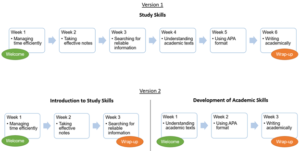Authored by:

Brenda Cecilia Padilla Rodriguez & Alejandro Armellini
Brenda is an academic, researcher and worldwide consultant. Her main affiliation is at the Universidad Autonoma de Nuevo Leon in Mexico. She is a psychologist with a master’s degree in cognition and education. She studied her PhD at the University of Leicester. Ale is Professor and Dean of Digital and Distributed Learning at the University of Portsmouth, United Kingdom. He holds a PhD from the University of Kent and a Master’s degree in Educational Technology and TESOL from the University of Manchester.
Does splitting a longer course into two short ones increase overall completion rates? We did this for one massive, open and online example
Since their appearance in 2008, Massive Open Online Courses (MOOCs) have become prevalent within higher education. As prestigious institutions offer them free of charge or sometimes for a small fee, MOOCs are an attractive option for students worldwide. They commonly have thousands of enrolled users. However, few people actually complete them.

Most MOOCs are between six and ten weeks long. As they progress, engagement tends to decrease and participants drop out. We wondered if shorter MOOCs could prevent this “funnel participation” phenomenon. Previous research on the topic is descriptive. It compares existing MOOCs with MOOCs of different durations and, thus, a variety of factors other than the length of the course – such as the topic, type of assessment or pedagogical approach – could explain the different levels of learner participation. Our question remained: Could dividing MOOCs into smaller chunks be enough to make them more engaging?
What we did
We redesigned a Study Skills MOOC, which was the product of an alliance between the Autonomous University of Nuevo Leon (Mexico) and the University of Northampton (United Kingdom). The course focused on first-year university students. It aimed to help them transition to higher education, improve their study skills and develop their self-efficacy, i.e., their beliefs about their capabilities to produce expected outcomes. It covered six study skills:
- Managing time efficiently
- Taking effective notes
- Searching for reliable information
- Understanding academic texts
- Using the APA referencing format
- Writing academically
Students were encouraged to reflect on their own experiences, share their stories, practice and define action plans for improvement. The recommended study time was three hours per week.
We created two versions of this MOOC (see Figure 1). Version 1 was a six-weeks long MOOC. It had six lessons (one per study skill), plus welcome and wrap-up activities at the beginning and end of the course. Version 2 divided the content and activities of Version 1 into two shorter MOOCs, each three-weeks long. They were titled “Introduction to Study Skills” and “Development of Academic Skills”. Each of them had their own welcome and wrap-up activities. At the end of the Introduction to Study Skills MOOC (i.e., the first three weeks), we invited participants to join the Development of Academic Skills MOOC.
These MOOCs were delivered sequentially, so learners were engaged in six consecutive weeks. In both versions, after the six weeks, participants had additional time available to complete activities. Those who completed Version 1 or both shorter MOOCs in Version 2 could obtain a non-credit bearing certificate of participation. The key difference between the versions was solely the length of the MOOCs.

Figure 1. Versions of the MOOC (Padilla Rodriguez, Armellini, & Rodriguez Nieto, 2020)
To determine which version was most effective, we identified active users (i.e., those who attempted multiple-choice exercises, answered surveys or posted messages), those who remained engaged throughout the different lessons, and those who earned a certificate of participation. Additionally, during the first and final lessons of the MOOCs, we invited students to answer the Spanish version of the General Self-Efficacy Scale and six items that addressed specific study skills. They could also share optional comments.
What we found
Participants in both versions referred initially to the difficulties they faced regarding their study skills. After completing the six weeks, they consistently expressed appreciation and gratefulness for the experience. Many comments focused on learning, or on general benefits derived from studying the MOOC. In line with this, both versions of the MOOC were successful, in that they helped learners fulfill the goal of developing their confidence in their own capabilities. Those who completed the six lessons reported statistically significant increases in their self-efficacy, both in general and, specifically, in relation to their study skills. This lack of differences is unsurprising considering that the content and activities were the same.
However, when the six-week course (Version 1) was divided into two three-week MOOCs (Version 2), there were other significant improvements. In Version 2, students went beyond expressions of MOOC benefits. They described specific ways in which they were able to apply their learning in their own contexts or how the course had been meaningful for them. For example, one said: I am really very happy because a few days ago I had to do an assignment related to the last topic I saw in this course. It was very useful for me. Many thanks. (:
The depth and quality of participants’ engagement increased. Interactions with content, peers and facilitators more than doubled in terms of average course views, number of messages posted and percentage of active participants throughout the six lessons. Moreover, student retention was higher, Completion rates quadrupled from Version 1 (15.6%) to Version 2 (61.8%). This is particularly interesting because although both versions shared essentially the same content, Version 2 had two welcome and wrap-up activities. Completing it required more work than Version 1 and yet, learners were more likely to participate and finish it. Why?
Maybe students considered Version 2 more manageable, as it divided a goal that took six weeks into two smaller goals. Finishing the first three-week MOOC might have offered a motivating sense of accomplishment, which led students to want to engage in the second three-week MOOC. Or maybe the difference related to social interactions. In Version 2, learners posted on average three times more messages than in Version 1. These communications might have modeled positive engagement. Alternatively, in Version 1, some learners might have dropped out when they saw others disengaging from the course. We need more research to know for sure!
What we learned
This study offers evidence in favour of short, modularised courses. Simply dividing a six-week MOOC into two three-week MOOCs resulted in higher effectiveness. Nevertheless, we have new questions: How short can a MOOC be before learner engagement and retention stops improving? What other factors can affect student participation and completion? Answers will help MOOC designers and developers create effective, engaging courses.
Read more:
Padilla Rodriguez, B. C., Armellini, A. & Rodriguez Nieto, M. C. (2020). Learner engagement, retention and success: why size matters in massive open online courses (MOOCs). Open Learning: The Journal of Open, Distance and e-Learning, 35(1), 46-62.
[A .pdf version of this article is available for download here]
Authored by:

Brenda Cecilia Padilla Rodriguez & Alejandro Armellini
Brenda is an academic, researcher and worldwide consultant. Her main affiliation is at the Universidad Autonoma de Nuevo Leon in Mexico. She is a psychologist with a master’s degree in cognition and education. She studied her PhD at the University of Leicester. Ale is Professor and Dean of Digital and Distributed Learning at the University of Portsmouth, United Kingdom. He holds a PhD from the University of Kent and a Master’s degree in Educational Technology and TESOL from the University of Manchester.
Leave a Reply